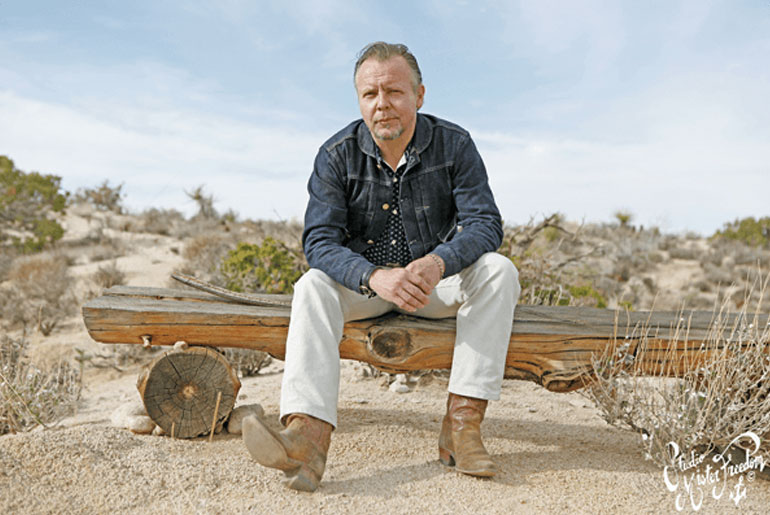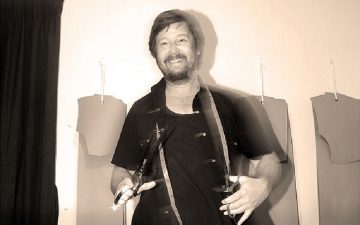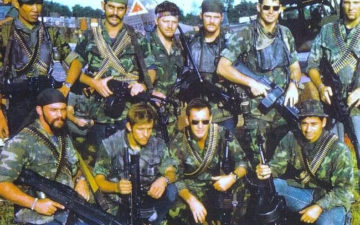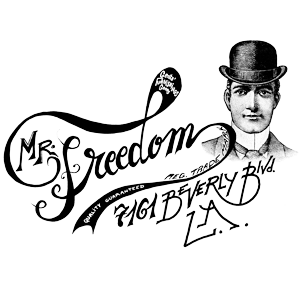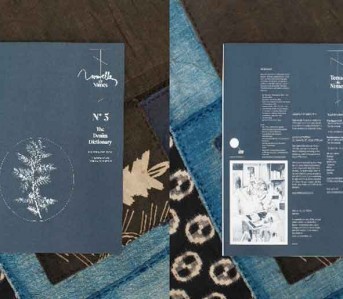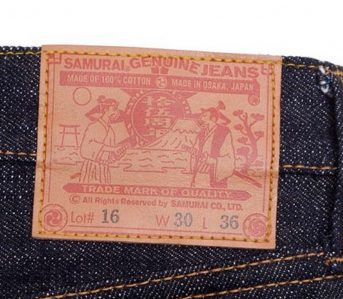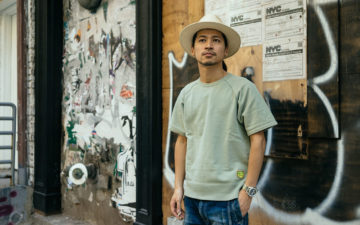Originally hailing from France, Christophe Loiron is the founder and designer behind the esteemed California-based brand, Mister Freedom. Loiron is known for his relentless dedication to vintage menswear and it is through his brand – which doubles up as a retail space and creative design studio – that we see his passion come to life.
We had a chance to catch up with Loiron and hear some of his thoughts on his musical inspirations, washed denim, and how the industry has changed since Mister Freedom‘s launch in 2003.
RD: What is the significance of raw denim to you?
CL: “Raw denim” means to me the only way denim should be sold to consumers. Not distressed, 100% solid. This is less of a personal aesthetics statement than about ethos I wish the entire Garment Industry shared.
RD: The name, Mr. Freedom, was inspired by the original William Klein movie from 1969. Aside from some of the aesthetic details that you admired during specific scenes, what was it about the film (and name) that got you thinking about your brand and vision?
CL: The movie had no impact on what I had in mind, since I picked the name before seeing it. Didn’t have any impact after I saw it either. I just liked the red/white/and blue graphics theme that reminded me of old school 70’s army surplus stores I liked as a kid. The name had more appeal to me. I like the illusion of personal freedom in one’s life.
RD: Though California is your home base, are there any other parts of the United States that appeal to you? If so, why?
CL: Everywhere is nice if you meet the right people. Love the energy of New York, what I know of Santa Fe, the scenery in Joshua Tree. I used to drive around from South Texas back to L.A. during the vintage clothing boom of the 1990’s. I enjoyed discovering the cradle of everything I obsessed about as a kid. Some parts of America still looked like movie sets. Old town squares, pick-up trucks, tumbleweeds, cactus, oldies on the radio, folks in western hats and boots…
But there is no place I called home until I settled in California 23 years ago. Almost no one is considered a foreigner here, since most people come from out of state or country.
RD: You’ve been known to be heavily influenced by a range of music genres, from early traditional jazz all the way to 1950’s rockabilly and 1960’s Rock ‘n Roll. What is it about music from these older time period that you favor? Are there any modern day musicians or genres you like and impact you?
CL: My Dad liked Jazz. Loved Django Reinhardt, thought Louis Prima was too commercial but dug Sinatra. He also loved Western movies soundtracks. I was raised listening to vinyls, not so much local radio. So I was never well versed in current Top 40, boys bands and contemporary teen idols. What I like sounds old, and what sounds old is comforting to me.
I now listen to a very eclectic mix of music, usually real people playing real instruments, with melodies beyond a sequencer loop and a beat not handled by a drum machine. Anything contemporary that I like comes from people influenced by roots music. I like when a band like “Old Crow Medicine Show” comes out in the pop charts. I like when an old timer like James Hunter gains popular approval after a song like “People Gonna Talk”.
Really looking forward the release of JD McPherson new album this year. I was floored when I saw them perform live with Jimmy Sutton on bass a while back. Again, real people, real instruments.
RD: Aside from music, what or who else do you look to for creative ideation (if any)? Or are there any cultural concepts or figures that play a role in your designs decisions?
CL: Roots music led me to be attracted to vintage clothing early on, before ‘vintage’ was a popular word. I’m attracted by the origin of things in general, and tend to look back more often than ahead. I find History fascinating and would take a good documentary any second over a Sci-Fi movie.
Inspiration is everywhere for me. A radio show, an old photo, a book, a memory. I do not look at what other brands are doing however. I am sure there are great things being designed, but I would hate to take any credit for what a contemporary brand is already doing. And since I always like to cite my sources when introducing a new garment or concept collection, I would feel a bit silly.
RD: How did the collaboration with Sugar Cane & Co. come to be? If you’re ever to partner up with a specific brand or company, do you have a criteria or process in mind?
CL: It has been a Gentlemen’s agreement since 2006, when a team from Japan visited the store and asked if I’d collaborate with them on a pair of jeans. I would design and they would take care of the manufacturing and selling in Japan. Toyo Enterprises was mostly specialized in military, workwear and aloha shirts replicas back then, under several labels such as Sugar Cane, Buzz Rickson’s etc.
They knew I had a background in vintage clothing and they had been coming to the store for some time, buying some graphics and other ones-of I made. I came up with a pair of jeans so remote from a basic 5 pocket that someone referred to them as “Frankenjeans”, I believe. Some folks liked them, however, and those “7161 Utility Trousers” from 2006 are now somewhat collectible.
Our ongoing MFSC collaboration still works on that original hand shake. The collections are now larger, more involved, and denim is just one aspect of them.
I very much respect the folks at Toyo Enterprises and I am happy to call some friends today. That company is as remote from a ‘garmento’ type as Mister Freedom® is. They mean business, but they have ethics and not everything is about profit.
RD: Is there anything you’d love to see done/made in the denim world but doesn’t currently exist? On the flip side, what would you like to see done/made less?
CL: Since you’re asking…I have always denounced the absurdity of ‘distressed’ denim, whether achieved by sandblasting, stonewashing, chemicals, “dry” wash, hand sanding… I’ve made a few ‘enemies’ in this Industry because of my loud mouth.
There is SO much money involved in ‘washed denim’ (manufacturing, washing, retailing and advertising it) that only a few rogues dare to speak up. My rants are very often edited out in interview.
A ‘vintage wash’ is an unnecessary step between the brand and the consumer, and an insult to a buyer’s intelligence. Wearing factory-aged jeans not only makes one look like a Clorox commercial, but is a way of supporting a very polluting industry dumping chemicals in rivers, wasting precious water, often in awful work conditions.
I visited one factory in Guatemala in 2005. Workers wore mere bandanas against chemicals and silica sand particles. Sandblasting (causing lung diseases for ‘wash house’ factory workers) is still very active in China, Turkey, Bangladesh in 2013. Of course, not according to major brands PR announcements, as that process is supposed to be banned.
Unfortunately, because of an artificially created demand for fake ‘vintage denim’, people think that raw denim is not soft enough. Even Zoolander could figure out that all it takes to soften a garment is to naturally alternate wear and wash.
RD: How do you feel you and the industry has changed since Mister Freedom launched in 2003?
CL: Japan has revolutionized the denim world since the early 1990’s. First there were avid collectors going around the country hitting the Army Navy stores to score New Old Stock 501’s, when barely no one cared about an old pair of Levi’s. Even said company. Then, after replica brands, fashionable Japanese denim brands started to appear, their owners often early collectors of vintage clothing.
Old shuttle looms, selvedge, indigo – these words were not part of the average conversation back then. I personally remember a road trip sometime in 1992 when I would pass on $5.00 vintage Levi’s in thrift stores, because they were not my size.
Some 20 years later, Denim is King. Hundreds of monster labels, countless small artisanal brands, some 2 billion jeans manufactured a year, fortunes made and lost, precious resources wasted; all in the quest for Blue Gold.
Specialized blogs, indigo experts, denim-heads, fading processes skillfully documented, photos of back legs, technical reports on how to launder jeans. I take it all with a grain of salt, and a spoonful of humor. We’re not talking about solving world hunger here.
RD: If you could be doing anything besides what you’re doing now, what would it be?
CL: Besides longing for a zodiac pilot position around Tahitian motus, I would enjoy making documentary films about controversial topics, I think. I find acquiring knowledge to be exhilarating, shedding light on things and sharing the truth satisfying.
RD: Any plans for the remainder of 2013 and beyond? Can we expect an expansion — online and/or offline — and additions to your collection?
CL: We have just launched a new web store that is making things a lot simpler for international buyers interested in what we do. This was a big step for this small company.
Also, leaving for Tokyo next week to show a new Mister Freedom x Sugar Cane concept collection for Spring 2014, a departure from our previous stylistic ventures. Stay tuned, as it will involve ‘looking for treasures’… 😉
